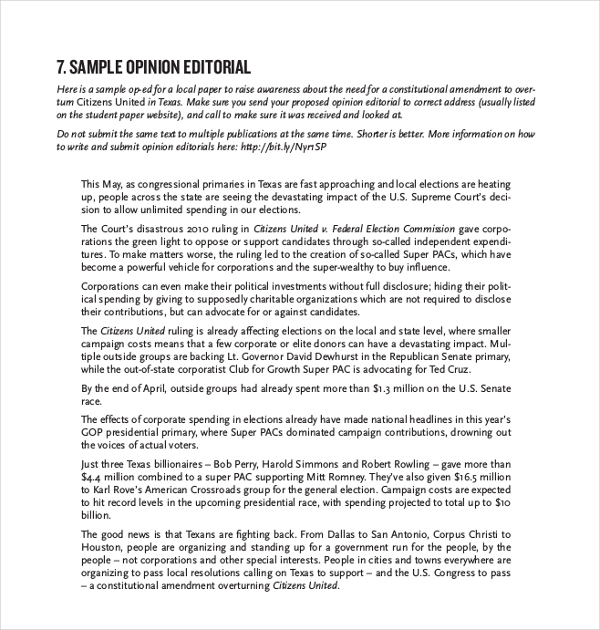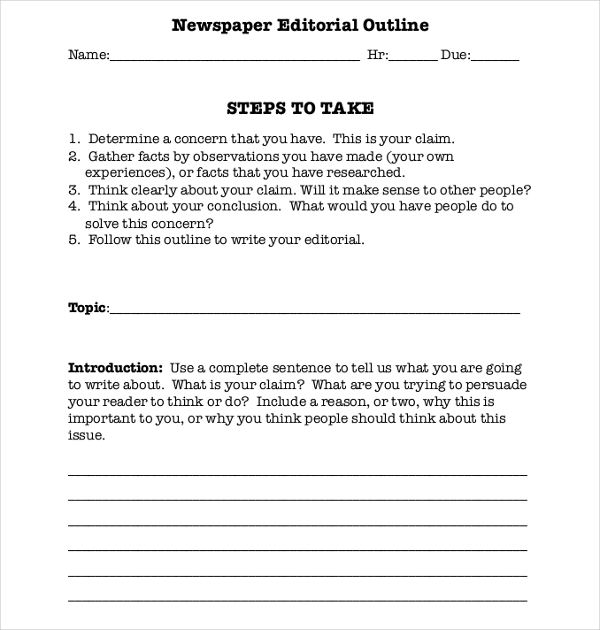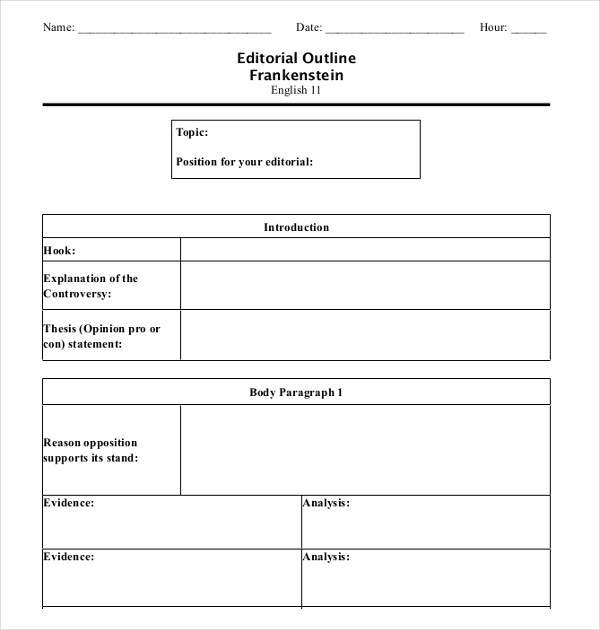News Editorial Outline Examples to Download
All of us have our own personal opinions on today’s issues. Most, if not all of the time, it is often voiced out on social media since it is the easiest platform to engage in discourse among all the other platforms available. But there are also sections found within the paper that expresses the newspaper’s opinion on a certain issue. This is called an editorial.
Characteristics of Editorial Writing
An editorial reflects the majority vote of the editorial board; the governing body of the newspaper made up of editors and business managers. However, in some cases, the editorial section is not always written by the personnel in the newsroom, but it is written by other personalities who are connected to the newspaper organization. Similar to a persuasive speech, the role of the people writing their opinions on the paper is to convince and persuade their audience to share their point of view in some of today’s issues. Not only are they are meant to influence public opinion, but also to promote critical thinking, and other times to let people to take action on an issue. In essence, an editorial is an opinionated news story.

What consists of an editorial:
- Introduction, body and conclusion. Once you start with something, allow your thoughts to slowly transition all the way to the end.
- An objective explanation of the issue. There may be some readers who are ignorant or simply new to the said issue at hand. It is important if you provide a brief overview to the readers so that they may be aware of what is going on these days. You may also see essay outlines.
- A timely news angle. Since an editorial is likened to a news story (of sorts), it is important that the editorial has an angle of its own to be able to present a new light. You may also see speech outlines.
- Opinions from the opposing viewpoint that refute directly the same issues the writer addresses. It is good or healthy even to exercise your right to speak out what you need to say, even if it might offend someone in the process. For instance, on the issue of owning an assault rifle as early as 18 years old, you are free to state on your editorial on why the U.S. does not have a stronger gun ban control like that of other countries. You may also see program outline.
- The opinions of the writer delivered in a professional manner. As a representative of a newspaper organization, it is important that you must remain civil and professional at all times. Do not reduce yourself to pure name-calling as it is not only derogatory, but it indicates how immature you are as as person. You may also see script outline.
- Alternative solutions to the problem or issue being criticized. Instead of adding to the problem, why don’t you become a part of the solution? Government officials read the newspapers too, you know. Make use of that space in the editorial to send a wake-up call to the audience on what you think they can do towards that certain issue for the betterment of society. You may also see thesis outline.
- A solid and concise conclusion that powerfully summarizes the writer’s opinion. Start strong and end strong. Have a take-away that your readers can recall when he forgets everything else. You may also see research paper outline.
Sample Editorial Opinion Example
Four Types of Editorials:
1. Explain or interpret: This is the kind of editorial that explains the issues, not as the reporter, but through the eyes of an ordinary citizen. In that said editorial, allow the readers to have a full understanding of what society is being faced with today and explain it in such a way that everyone understands what you are trying to say. You may also see training outline.
2. Criticize: Let the venting games begin! One good thing about editorials is that you are granted the freedom to air out your complaints without getting shot at for speaking bad against the government. Although this is a democratic country, please be careful not to add profanity to your article that will just reflect your being unprofessional. While ranting out your complaints to the system, it is also important to indicate the proposed solution you have in mind. The immediate purpose is to get readers to see the problem, not the solution. You may also see rough outline.
3. Persuade: These kinds of editorials immediately present the solution to the issue, and not the problem. Just from the first paragraph alone, the readers are encouraged to take a specific course of action to become part of the solution to that problem. You may also see book outline example.
4. Praise: These are the rarest kind of editorials to be written as these usually commend people for their efforts.
Writing an Editorial
1. Choose a significant topic that might pique the readers curiosity, having a current news angle.
2. Even if you are just going to write an editorial piece, it is important to conduct thorough and detailed research.
3. Keep your opinion short and simple. Present it like a thesis statement.
4. Elaborate the issue like a reporter objectively and explain the issue’s importance to society.
5. Present the opposing viewpoint with facts and quotes from sources.
6. Reject the other side and develop your case using facts, details, figures, quotations. Pick apart the other side’s logic.
7. Concede a point of the opposition. You may also see leadership outline.
8. Try to repeat key words and phrases so that the audience’s memory will be jogged from time to time.
9. Suggest a solution that is not only creative, but out-of-the-box at the same time. Presenting an innovative and unique solution is something encourages critical thinking and a call to action among the members of the audience. You may also see resume outline.
10. After stating the main points in your editorial, make sure to reiterate the whole gist of your piece.
11. Limit your editorial piece to only 500 words. So, learn to make every word count. You may also see project proposal outline.
Newspaper Editorial Outline Example
Editorial Outline Sample
I. Lead with an Objective Explanation of the Issue/Controversy.
Similar to writing the news, it is always important to start off with the most significant details to the least important. In your opening statement of the editorial, it should answer the questions: who, what, when, where and why as well as how. (i.e. Two areas in the South China Sea are being considered for a “joint exploration” by the Philippines and China…)
- Pull in additional facts and quotes to add substance to the story itself.
- Conduct additional research about the subject matter if it is deemed necessary to provide a stronger backing to your opinionated news story. You may also see presentation outline.
II. Present Your Opposition First.
As the writer of the editorial, you then present your own convictions and beliefs that do not sit well with the issue at hand. Identify the people who oppose you (i.e. This means that both the Philippines and China will own the area. Many including myself, do not believe that China will agree to a co-ownership situation of areas which it adamantly claims.)
- Make use of good research that will get facts and quotations for the issue.
- Make sure that your opposition is strong. Having a weak one will not help in your case.
III. Directly Refute The Opposition’s Beliefs.
From step 2, you can begin it with a transitioning sentence. (i.e. Since SC 57 is clearly within our area, why offer it up for co-ownership should there be a joint exploration of the area? According to the Constitution, the Philippines has the right to benefit from its own exclusive economic zone, as part of its territory. You may also see free outline examples
- Aside from getting reference from people and facts that support you belief, try to concede a valid point of the opposition which will make you appear rational, one who has considered all the options.
IV. Give Other, Original Reasons/Analogies
Defend your position by stating your reasons accordingly from the strong to the strongest one. i.e. According to Professor Jay Batongbacal of the University of the Philippines Institute for Maritime Affairs and Law of the Sea, he sees this whole co-ownership thing as giving China too much, too soon. You may also see documentary outline.
- Utilize literary or cultural allusions that may lend to your credibility and perceived intelligence
V. Conclude With Some Punch.
Present solutions to the said problem or challenge the reader to be informed. i.e. Perhaps the Palace should come up with another explanation of what Philippine President Rodrigo Duterte actually meant when he said that a joint exploration entails co-ownership. As I previously said, any joint thing with China must be written in black and white, even on a stone where disputes are present, if only to make sure everyone is on the same page. You may also see APA outline examples.
- A quotation can be effective, especially if from a respected source
- A rhetorical question can be an effective way of concluding the editorial
Editorial Outline Example
On a little side note, even editorials are prone to getting sued by the respective parties mentioned in the story. So, it is important to practice professionalism and ethical writing when voicing out your opinions for the whole public to hear. You may also see tentative outline.





